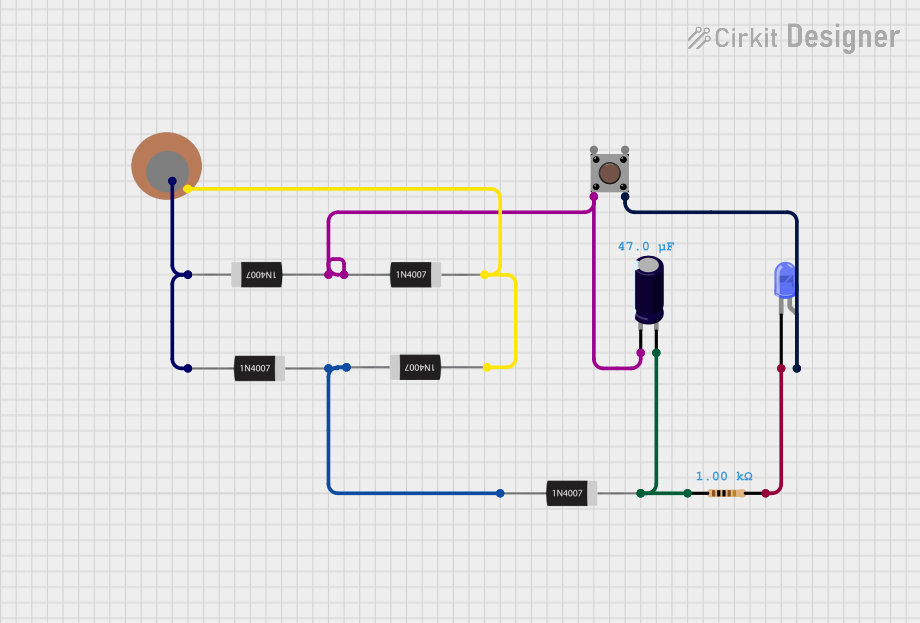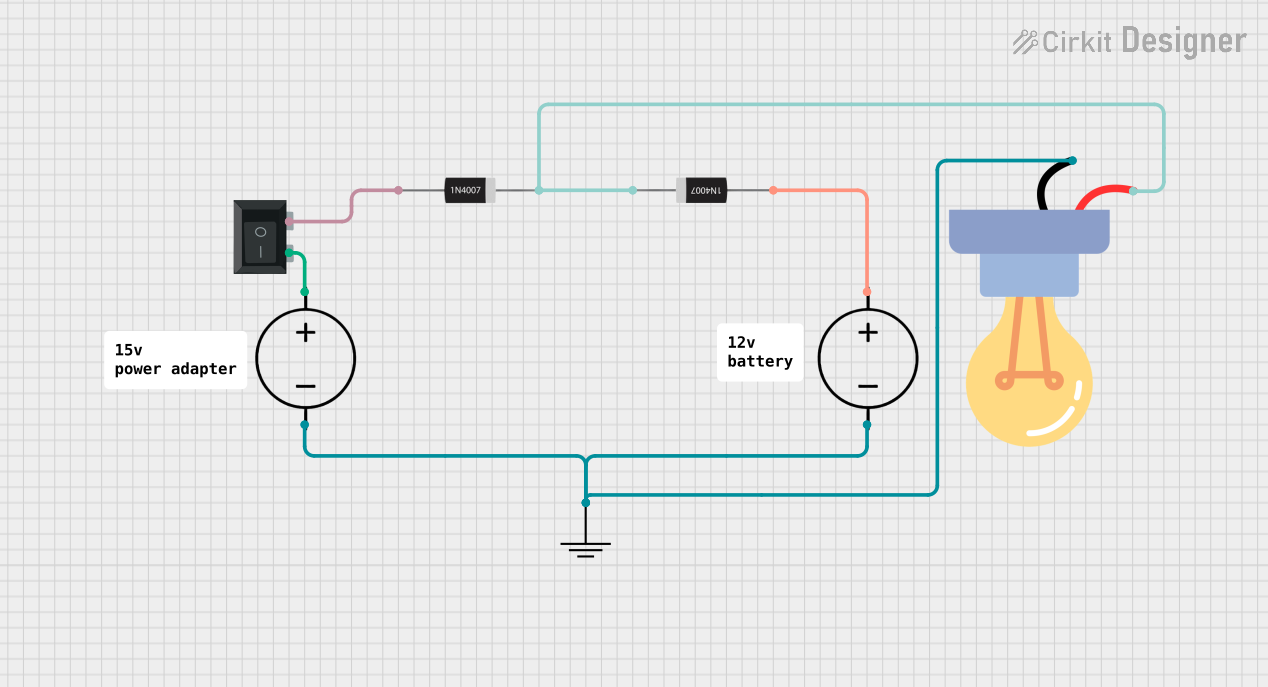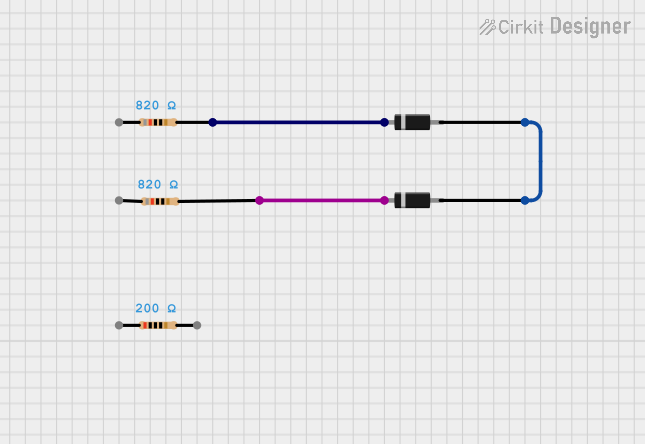
How to Use Diode 1N4148: Examples, Pinouts, and Specs

 Design with Diode 1N4148 in Cirkit Designer
Design with Diode 1N4148 in Cirkit DesignerIntroduction
The 1N4148 is a small-signal switching diode widely recognized for its fast switching speed and low forward voltage drop. It is a highly reliable and versatile component, making it a popular choice in a variety of electronic circuits. The 1N4148 is commonly used in applications such as signal processing, rectification, and high-speed switching.
Explore Projects Built with Diode 1N4148

 Open Project in Cirkit Designer
Open Project in Cirkit Designer
 Open Project in Cirkit Designer
Open Project in Cirkit Designer
 Open Project in Cirkit Designer
Open Project in Cirkit Designer
 Open Project in Cirkit Designer
Open Project in Cirkit DesignerExplore Projects Built with Diode 1N4148

 Open Project in Cirkit Designer
Open Project in Cirkit Designer
 Open Project in Cirkit Designer
Open Project in Cirkit Designer
 Open Project in Cirkit Designer
Open Project in Cirkit Designer
 Open Project in Cirkit Designer
Open Project in Cirkit DesignerCommon Applications:
- High-speed switching circuits
- Signal rectification
- Clipping and clamping circuits
- Logic circuits
- Protection diodes in low-current applications
Technical Specifications
Below are the key technical details of the 1N4148 diode:
| Parameter | Value |
|---|---|
| Maximum Reverse Voltage | 100 V |
| Forward Voltage Drop (Vf) | 0.7 V (typical at 10 mA) |
| Maximum Forward Current | 300 mA |
| Reverse Current (Ir) | 25 nA (typical at 20 V) |
| Reverse Recovery Time (trr) | 4 ns |
| Power Dissipation | 500 mW |
| Operating Temperature Range | -65°C to +175°C |
| Package Type | DO-35 (glass axial package) |
Pin Configuration
The 1N4148 diode has two terminals:
| Pin | Description |
|---|---|
| Anode | Positive terminal (current flows in) |
| Cathode | Negative terminal (current flows out) |
The cathode is typically marked with a black or white band on the diode body.
Usage Instructions
How to Use the 1N4148 in a Circuit
- Identify the Terminals: Locate the cathode (marked with a band) and the anode.
- Connect in the Correct Orientation: Ensure the anode is connected to the positive side of the circuit and the cathode to the negative side for forward-biased operation.
- Choose Appropriate Resistors: If used in a signal or rectification circuit, calculate and include a current-limiting resistor to prevent exceeding the maximum forward current.
- Observe Voltage Ratings: Ensure the reverse voltage in the circuit does not exceed 100 V to avoid damage.
Example Circuit: Signal Rectification
The 1N4148 can be used in a simple half-wave rectifier circuit. Below is an example of how to connect it to an Arduino UNO for signal rectification:
Circuit Description:
- The 1N4148 diode rectifies an AC signal into a DC signal.
- A resistor and capacitor are used to smooth the output.
Arduino Code Example:
// Example: Reading rectified signal with Arduino UNO
// This code reads the rectified signal from an analog pin and prints the value
// to the Serial Monitor. Ensure the input signal is within the Arduino's ADC range.
const int analogPin = A0; // Analog pin connected to the rectified signal
void setup() {
Serial.begin(9600); // Initialize serial communication at 9600 baud
}
void loop() {
int signalValue = analogRead(analogPin); // Read the rectified signal
Serial.print("Signal Value: ");
Serial.println(signalValue); // Print the signal value to the Serial Monitor
delay(500); // Wait for 500 ms before the next reading
}
Important Considerations:
- Reverse Voltage: Do not exceed the maximum reverse voltage of 100 V.
- Current Limiting: Always use a resistor to limit the current through the diode.
- Temperature: Ensure the diode operates within the specified temperature range.
Troubleshooting and FAQs
Common Issues and Solutions:
Diode Not Conducting in Forward Bias:
- Cause: Incorrect orientation of the diode.
- Solution: Verify the anode and cathode connections. The cathode should be connected to the negative side of the circuit.
Diode Overheating:
- Cause: Excessive current through the diode.
- Solution: Add a current-limiting resistor to ensure the current does not exceed 300 mA.
No Output in Rectification Circuit:
- Cause: Insufficient input signal or damaged diode.
- Solution: Check the input signal and replace the diode if necessary.
High Reverse Leakage Current:
- Cause: Operating the diode near its maximum reverse voltage.
- Solution: Reduce the reverse voltage or use a diode with a higher reverse voltage rating.
FAQs:
Q: Can the 1N4148 be used for high-current applications?
A: No, the 1N4148 is designed for low-current applications with a maximum forward current of 300 mA.Q: How do I identify the cathode on the 1N4148?
A: The cathode is marked with a black or white band on the diode body.Q: What is the typical forward voltage drop of the 1N4148?
A: The typical forward voltage drop is 0.7 V at 10 mA.Q: Can the 1N4148 handle high-speed switching?
A: Yes, the 1N4148 has a fast reverse recovery time of 4 ns, making it suitable for high-speed switching applications.